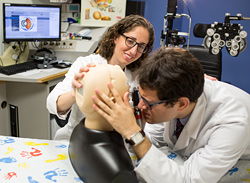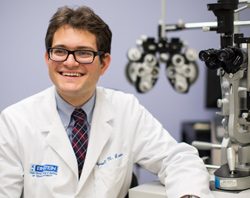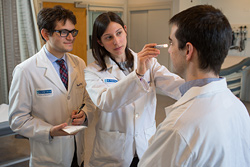

Essential Eye Skills
Learning Critical Skills to Save Sight
There is a saying that “the eyes are the windows to the soul.” Dr. Roy Chuck, professor and chair of ophthalmology & visual sciences at Einstein and its University Hospital, Montefiore Medical Center, takes this notion a bit further, noting, “I believe the eyes are the windows to our bodies.”

Dr. Jamie Rosenberg with Russ LevineEye exams are a critical tool in providing preventive healthcare services. They can aid a physician in observing early signs of eye diseases, such as retinopathy and glaucoma, as well as in detecting complications influenced by other diseases such as, diabetes, hypertension and increased intracranial pressure.
Over the years, however, training medical students in the use of an ophthalmoscope to perform eye examinations has been phased out of core medical school curriculum in the United States. The hand-held instrument helps one to look through the pupil to view the optic nerve and retina.
According to Dr. Chuck, who also is a professor of genetics at Einstein, the dearth in training with the ophthalmoscope has resulted in fewer primary care physicians performing preliminary eye exams, requiring patients to visit specialists, such as ophthalmologists, instead.
“Unfortunately, compliance rates for going to specialists are generally poor,” said Dr. Jamie Rosenberg, assistant professor of ophthalmology & visual science and of pediatrics at Einstein and director of medical student education at Montefiore Medical Center, the University Hospital for Einstein. “Often, by the time a patient visits an eye specialist, it can be too late.”
Seeing an Opportunity & Taking Action
Determined to make the ophthalmoscope a more approachable tool, Dr. Rosenberg has developed a curriculum for training third-year medical students to properly perform eye exams using the instrument. “If medical students become more confident and proficient in performing these exams, they’ll be more likely to conduct them during patient visits as part of their routine practice.”

Third-year medical student, Russ LevineShe added, “Since patients see their primary physicians more routinely, these doctors will be able to discern signs of a problem that could require referral to a specialist. That would help significantly with identifying a serious problem at a stage when something can be done to treat it.”
The new curriculum evolved from a summer research project conducted by third-year medical student Russell Levine during his second year, supervised by Dr. Rosenberg. The study was designed to evaluate students’ comfort with using the ophthalmoscope. “While it can be frustrating to master at first, with practice it becomes easy,” noted Mr. Levine. “The exam typically takes less than one minute, and the information gleaned can be very meaningful.”
Helpful Study Insights
The duo developed a novel method for assessing the accuracy with which students were visualizing the optic nerve. Using this process, they measured the students’ performance before and after the training. They found that the training improved both the students’ comfort and proficiency with using the ophthalmoscope, while also providing the trainers a means for identifying when a student needed further assistance.
“I was drawn to ophthalmology because of the measurable differences it can make in the lives of patients,” said Mr. Levine. “The project provided me an opportunity to be actively involved in developing a program that encourages medical students to use the ophthalmoscope. Once you know how to use it properly, it’s really a helpful tool for detecting changes in the eye that can signal when there’s a problem.”

Students practice all aspects of their examination skills on one anotherHe added, “The only exposure to using an ophthalmoscope that we got as medical students before now was during our second-year Introduction to Clinical Medicine course. It was part of a two-and-a-half hour session where we were shown how to perform eye, ear, nose and throat examinations.”
Providing Useful Training
The new program, provided to third-year medical students during their internal medicine rotation at Montefiore, consists of a half-day curriculum that includes simulation sessions, followed by practice on patients in the eye clinic and on each other.
And, thanks to a $10,000 donation from the Bronx Lions Club, the program has expanded. Using the funds, Dr. Rosenberg was able to purchase 50 low-cost ophthalmoscopes that are loaned to students so they can gain confidence performing eye exams during their internal medicine rotation. Half of the students rotating at Montefiore and all of the students rotating at another Einstein affiliate, Jacobi Medical Center, receive an ophthalmoscope for use during the six-week period.
“While the students at Jacobi do not receive the same training we offer at Montefiore, they have access to the instrument to gain familiarity with using it,” explained Dr. Rosenberg. “We’re studying the effectiveness of each approach – use with training sessions plus access to the instruments, versus only access to the loaner ophthalmoscopes – to assess how we can further improve students’ comfort and proficiency using the ophthalmoscope.”
“With the success of the assessment tool and training, Jamie and Russ have been invited to present their study at national medical education forums,” said Dr. Chuck. “And, the Bronx Lions Club’s grant is an example of the support it has provided our ophthalmology training and research programs at Einstein-Montefiore.” (Dr. Chuck is a member of the organization.)
“We’re grateful to the Lions’ Club for their support,” added Dr. Rosenberg. “They were excited to learn how our program teaches students a skill that can benefit patients.”
Indeed, equipped with greater confidence and newfound skill using an ophthalmoscope, third-year students at Einstein can set their sights on administering improved care to the patients they will ultimately treat.
Posted on: Monday, December 30, 2013

Tablet Blog